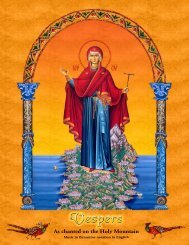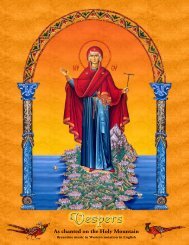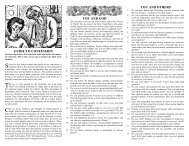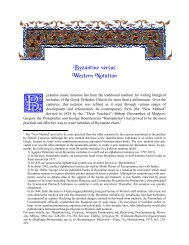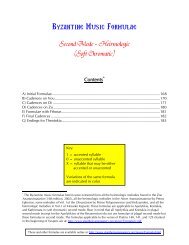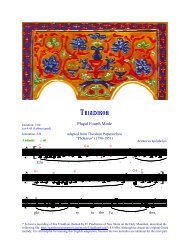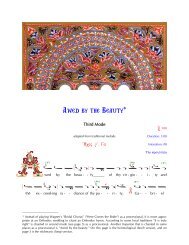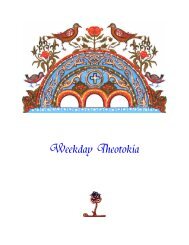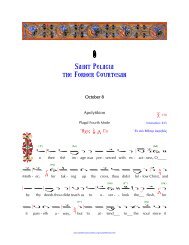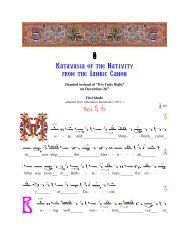Reading Psalmodia (PDF) - St. Anthony's Monastery
Reading Psalmodia (PDF) - St. Anthony's Monastery
Reading Psalmodia (PDF) - St. Anthony's Monastery
Create successful ePaper yourself
Turn your PDF publications into a flip-book with our unique Google optimized e-Paper software.
7. THE TYPES OF HYMNS AND MELODIESThe hymns and melodies of <strong>Psalmodia</strong> are classified in several different ways. Oneimportant classification is into:• Idiomelon, a hymn sung to its own unique melody. The verses sung at a Lity arenormally idiomela. (Paradoxically, there have been rare occasions when a second hymnhas been set to an existing idiomelon. In such cases the original hymn is still known asan idiomelon, although it now shares its tune with another.)• Prosomia are hymns or verses sung to a standard melody which is the tune of anexisting hymn. The text of a prosomion should follow the exact metrical structureof its prototype, but in practise minor degrees of variation do occur.Unfortunately, many musical texts call automela prosomia!• Automela are the hymns to whose melodies the prosomia are sung. The hymn isan automelon because it is sung to its own tune. Despite the role of automela asstandard melodies, their melodies exist in very many different versions in bothwritten and oral traditions.• Prologoi are so called, according to the theorists, since they are the automelawhose first words are set before the text of the prosomia in the liturgical books toindicate to which tune the prosomion is to be sung.• Irmos: each ode of a Kanon consists of a sequence of prosomia known as tropariawhich are sung to the tune of an automelon which stands at the head of them inthe liturgical books and is known as the "irmos" of the ode. Most irmoi are alsoused as automela by many other prosomia. The "Irmologion" is a book containingthe irmoi of all the most used kanons and usually the most common prologoi. Itis an important reference work for a psaltes.Melodies are also classified into:• Irmic - melodies sung in the style of the troparia of the kanons,• <strong>St</strong>icheric - melodies sung in the style of opening verses of the Kekragenaria orthe Ainoi. Idiomela are always sung in the sticheric style.• Pappadic - melodies sung in the elaborate, slow, melismatic style used in themost solemn settings of the Cherubikon or Koinonikon.A different pattern of classification divides melodies into:• short or simple, (syntomon,) where generally each syllable is sung to one note,• slow or solemn, (argon,) where each syllable is normally sung to two or threenotes of melody (often then called argosyntomon), or to longer melismaticphrases,• elaborate or ornate irmic style, (kalophonikon,) where the singing of a singlesyllable of text may use very many notes. The elaborate style also useskratimata, passages of pure melody sung to meaningless syllables, "tererem" or"nananu" or suchlike.Pappadic melodies are written in either the slow sticheric style or the elaborate irmicstyle and are the longest and most ornate of all.Psaltic theorists also classify melodies according to their emotional quality:• the expansive or exultant, (diastaltikon,)• the poignant, sorrowful or sad, (systaltikon,)• and the serene or tranquil, (isychastikon.)14



